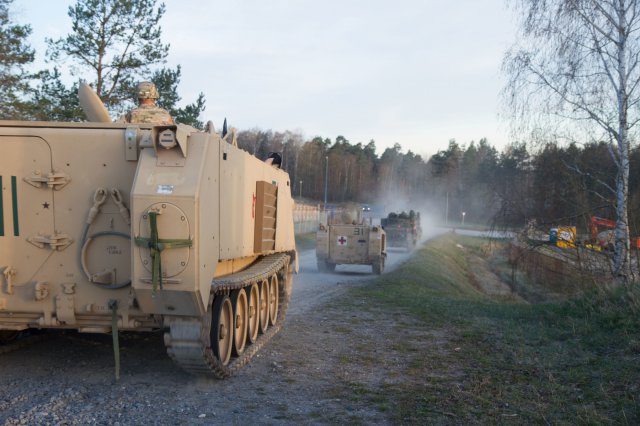GRAFENWOEHR, Germany: U.S. and German Soldiers teamed up to kick off a bilateral training exercise in Germany, April 16, as part of Operation Atlantic Resolve.
Operation Freedom Shock, which is scheduled to run through April 28, includes troops from 3rd Battalion, 69th Armor Regiment, 1st Armor Brigade Combat Team, 3rd Infantry Division, and the German 2nd Mechanized Battalion to increase training interoperability readiness between the U.S. and German armored forces.
Leaders from 3rd Battalion, 69th Armor Regiment, said the operation demonstrates the U.S. Army’s freedom of movement throughout Eastern Europe by showcasing its ability to project its forces any time and any place and to simultaneously gain interoperability with host nation forces.
“We don’t know where the next major incident is going to happen,” said Capt. Eric Flynn, commander, Company A, 3rd Battalion, 69th Armor Regiment [3-69 AR]. “We need to be able to test the systems and processes to make sure that when it does come, we’re not learning for the first time. We actually have tested the systems and we understand what we need to do to push that combat power where we need to be.”
Heavy equipment movement for this deployment readiness exercise was primarily facilitated by rail. Soldiers from 3-69 AR moved vehicles from their staging area on Camp Aachen to the railhead on Tower Barracks in Grafenwoehr, Germany. The final destination for this exercise is the German Army Combat Training Center in Letzlingen, Germany.
“Every single thing has to be strapped down, no matter how small it is,” said Pfc. Zane Lewis, Company A, 3-69 AR, a native of Orleans, Indiana, who prepared for this movement by ensuring his vehicle was ready for the rail.
For Bradley Fighting Vehicle driver Pfc. Brandon Bernier, Company A, 3-69 AR, originally from White Bear Lake, Minnesota, this was his first experience driving his vehicle onto a rail car.
“I have faith in our ground guides,” Bernier said. “I believe they’ll steer me straight and I’ll follow what they do.”
Flynn said that deployment readiness exercises have become a lost art during the last decade, explaining that everyone knew of the deployment cycle, which has become second nature.
“With the shift in missions, this has become a requirement,” he said. “It’s something that we have to get back on to so that we can push combat power to where it’s needed throughout the world. It reassures our NATO allies of our capabilities.”










